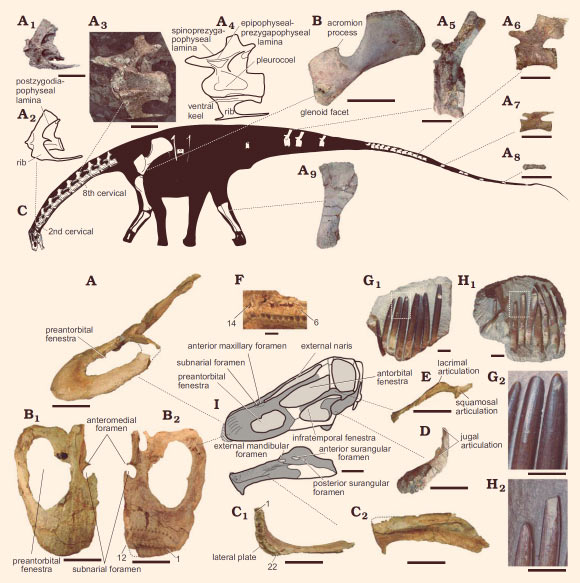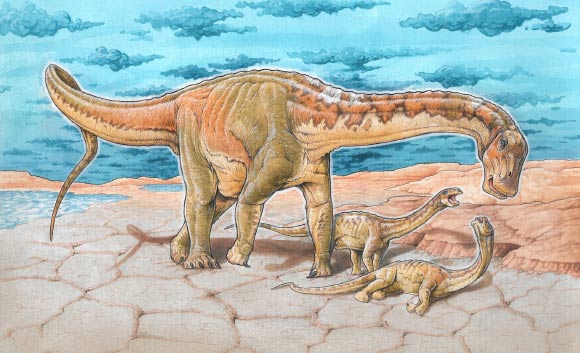A new species of sauropod dinosaur that stretched 39 feet (12 m) from head to tail has been unearthed in Patagonia, Argentina.
Dubbed Lavocatisaurus agrioensis, the new dinosaur is thought to have lived approximately 110 million years ago (Cretaceous period).
The creature was a type of sauropod, a group of huge plant-eating dinosaurs that includes the largest animals ever to walk the Earth.
One adult and two immature specimens of Lavocatisaurus agrioensis were recovered near the locality of Agrio del Medio, a small town in the central part of the province of Neuquén, Patagonia.
“We found most of the skull bones of Lavocatisaurus agrioensis: the snout, the jaws, a lot of teeth, also the bones that define the orbit of the eyes for example and, in that way, we were able to do a very complete reconstruction,” said Dr. José Luis Carballido, a paleontologist at the CONICET-Egidio Feruglio Museum.
“In addition, parts of the neck, tail and back of this species were found.”

Lavocatisaurus agrioensis. Top image: (A) an adult specimen, axis in lateral view (A1, photograph; A2, drawing); eight cervical vertebrae in lateral view (A3, photograph; A4, drawing); anterior caudal vertebra in lateral view (A5); middle caudal vertebra in lateral view (A6); posterior caudal vertebra in lateral view (A7); posteriormost caudal vertebra in lateral view (A8); left tibia in lateral view (A9); (B) left scapula from a juvenile specimen, in lateral view (C) skeletal reconstruction based on adult and juvenile specimens. Scale bars – 10 cm. Bottom image: (A) left maxilla from an adult specimen in lateral view; (B) right maxilla in anterodorsal (B1) and posteroventral (B2) views, numbers indicate the tooth positions; (C) left dentary in dorsal (C1) and lateral (C2) views, numbers indicate the tooth positions; (D) right squamosal (inverted) in lateral view; (E) right jugal (inverted) in lateral view; (F) dentary teeth, numbers indicate the tooth positions; (G) eight associated teeth in labial view (G1), close up of two teeth in labial view (G2), showing the absence of wear facets; (H) nine associated teeth in lingual view (H1), close up of the teeth in labial view (H2), showing the wear facets; (I) skeletal reconstruction, based on the adult specimen. Scale bars – 10 cm in A-E and 1 cm in F-H. Image credit: Canudo et al, doi: 10.4202/app.00524.2018.
The paleontologists estimate that adult Lavocatisaurus agrioensis grew to about 39 feet long, while juveniles were around 20-23 feet (6-7 m) long.
“The discovery was made in the center of the Argentinean province of Neuquén,” Dr. Carballido said.
“At that site, 110 million years ago, the environment was very desert, with sporadic lagoons, so we were surprised to find the fossils there.”
“Although it is estimated that this group of sauropods could have been adapted to move in rather arid environments, with low vegetation, with little humidity and little water, it is an environment in which one would not be looking for fossils.”
“The same aridity of the environment indicates that the fossil remains of these three individuals were not displaced and gathered next to a waterway, but that they moved in groups and died together.”
“There is no way to know if there was kinship among the members of this group, so it will be left to the imagination to guess if it was a father or a mother with two of their children.”
The discovery is reported in the journal Acta Palaeontologica Polonica.
_____
José I. Canudo et al. A new rebbachisaurid sauropod from the Aptian–Albian, Lower Cretaceous Rayoso Formation, Neuquén, Argentina. Acta Palaeontologica Polonica, published online October 29, 2018; doi: 10.4202/app.00524.2018








